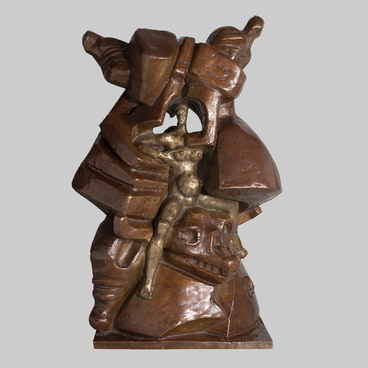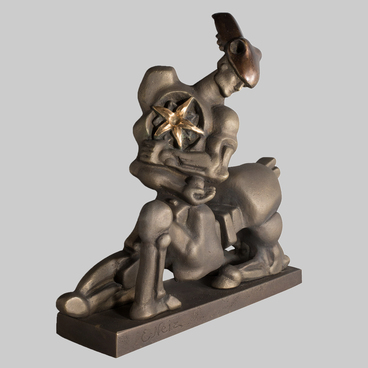The ancient legend of a monstrous half-man and half-bull confined to the depth of a gloomy maze and feeding on human sacrifices has more than once been depicted by artists and sculptors on canvas and in stone. Ernst Neizvestny interpreted this subject as a story of the masculine-feminine relationship. His naked woman character squatted under the weight of the massive bull’s body bearing hard on her; she set her hooves against the ground. The monster’s chops are open, the frightening teeth ready to occlude on the woman’s neck. But she looks as if she weren’t afraid, her hand is almost caressing the beast’s shoulder.
Various interpretations of the ancient story are possible. One theory is that Minotaur is a symbol of transition from matriarchy to patriarchy in the course of social evolution of the ancient world. In Neizvestny’s composition, the woman is kind of coming into a new existence, integrating in the brutal man’s flesh; her muscles are tense, the body twisted in anguish. Or in sensual pleasure?
The dual human nature is sculpted with striking power and expressiveness. But this is not the only message of the composition. On the bodies and underfoot, one can see parts of some mechanisms — levers, nuts. Minotaur’s body is angular, like that of a robot, with layered artificial shells on top. What we see is also a struggle of the human and mechanistic nature. Which of them will win? The answer is behind Minotaur’s back. A child’s face shows through the back of his head. A new life will sure defeat the primordial brutality and engineering-based civilization.
The eternal theme of relations between the masculine and feminine always fascinated Ernst Neizvestny and echoed in his art. He maintained that Russian culture ‘crucified the family’ and strove to make the viewers realize the threat of disintegration of the eternal unity and opposition of its entities. This idea is particularly important today that the traditional family finds itself under the pressure of new technologies, destruction of gender stereotypes, re-assessment of human being on the whole. The world is standing at the threshold of unusual transformations, with man and woman exchanging their roles and fusing with mechanisms and gadgets into a single whole.
Ernst Neizvestny called himself a ‘surviving patriarch’. It may be that war spared his life only to make sure a weighty word is spoken in defence of the human nature against relentless mechanistic civilization.
Various interpretations of the ancient story are possible. One theory is that Minotaur is a symbol of transition from matriarchy to patriarchy in the course of social evolution of the ancient world. In Neizvestny’s composition, the woman is kind of coming into a new existence, integrating in the brutal man’s flesh; her muscles are tense, the body twisted in anguish. Or in sensual pleasure?
The dual human nature is sculpted with striking power and expressiveness. But this is not the only message of the composition. On the bodies and underfoot, one can see parts of some mechanisms — levers, nuts. Minotaur’s body is angular, like that of a robot, with layered artificial shells on top. What we see is also a struggle of the human and mechanistic nature. Which of them will win? The answer is behind Minotaur’s back. A child’s face shows through the back of his head. A new life will sure defeat the primordial brutality and engineering-based civilization.
The eternal theme of relations between the masculine and feminine always fascinated Ernst Neizvestny and echoed in his art. He maintained that Russian culture ‘crucified the family’ and strove to make the viewers realize the threat of disintegration of the eternal unity and opposition of its entities. This idea is particularly important today that the traditional family finds itself under the pressure of new technologies, destruction of gender stereotypes, re-assessment of human being on the whole. The world is standing at the threshold of unusual transformations, with man and woman exchanging their roles and fusing with mechanisms and gadgets into a single whole.
Ernst Neizvestny called himself a ‘surviving patriarch’. It may be that war spared his life only to make sure a weighty word is spoken in defence of the human nature against relentless mechanistic civilization.

